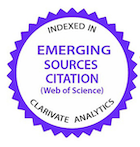Fuzzy logic discriminant function for evaluating goats exposed to verminosis occurrence regarding resistance, resilience, or sensitivity to parasitism
DOI:
https://doi.org/10.1590/1809-6891v24e-74727EAbstract
Worm infections pose a significant challenge to goat farming in the tropics. While individual variations in the animals' response to this disease are observed, understanding its genetic component is crucial for establishing effective herd production management, prioritizing the selection of goats with higher resistance to parasitism. This study aimed to assess goat response to worm infection under natural field conditions using data on eggs per gram of feces (EPG), body condition score (BCS), and conjunctival mucosa coloration (FAMACHA©). Cluster analysis and artificial intelligence (AI) techniques were applied to 3,839 data points from 200 individuals in an experimental goat herd in Piauí, Brazil. The study considered the phenotypic expression of resistance, sensitivity, and resilience to worm infection as responses to parasitism. Three clustering methods, namely Ward, Average, and k-means, were employed and compared with Fuzzy logic obtained through the CAPRIOVI web software. The analysis revealed statistically significant differences (P<0.05) between the groups of animals classified as resistant, resilient, and sensitive to parasitism. Pregnancy and peripartum were identified as stages of heightened sensitivity to parasitism (P<0.05). Among the clustering techniques, traditional statistical methods exhibited excellent performance, with an overall accuracy percentage exceeding 90.00%. In contrast, CAPRIOVI's fuzzy logic demonstrated lower overall accuracy (77.00%). The clustering methods showed similar efficiency, but differed in terms of the distribution of animals per group, with a tendency towards greater numbers in the resistant category. Fuzzy logic circumvented this limitation by enabling the formation of groups tailored to meet the producer's interests, adding consistency in terms of the animals' response to worm infection. This finding highlights the potential of the software for goat health management.
Keywords: artificial intelligence; body condition; discriminant analysis; FAMACHA©
Downloads
References
Lima CM, Tomazella VL, Evangelista AF, Campelo JE, Sousa Junior SC. Gamma-Gompertz mixture model with cure fraction to analyze data on Anglo-Nubian goats with positive EPG. Small Ruminant Research. 2022;106879. https://doi.org/10.1016/j.smallrumres.2022.106879
Oliveira WPS, Santos NPS, Oliveira MB, Araújo AM. Lógica Fuzzy para discriminar a resposta de caprinos a verminose: resistência, resiliência e sensibilidade. Revista Sodebras. 2022;17(197): 70-77. http://doi.org/10.29367/issn.1809-3957.17.2022.197.70
Embrapa Pecuária Sudeste, SARA, Solftware para análise de risco de desenvolvimento de resistência parasitária a anti-Helmínticos em ovinos. Embrapa Pecuária Sudeste-Fôlder/Folheto/Cartilha (INFOTECA-E), 2014.
Assenza F, Elsen JM, Legarra A, Carré C, Sallé G, Robert-Granié C, Moreno CR. Genetic parameters for growth and faecal worm egg count following Haemonchus contortus experimental infestations using pedigree and molecular information. Genetic Selection Evolution. 2014;46(1): 13. doi:10.1186/1297-9686-46-13
Dobson RJ, Hosking BC, Besier RB, Love S, Larsen JWA, Rolfe PF, Bailey JN. Minimizing the development of anthelmintic resistance, and optimizing the use of the novel anthelmintic monepantel, for the sustainable control of nematode parasites in Australian sheep grazing systems. Australian Vetererinary Journal. 2011;89(5): 160- 166. https://doi.org/10.1111/j.1751-0813.2011.00703.x
Torres TS, Sena LS, Santos GV, Figueiredo Filho LAS, Barbosa BL, Sousa Junior A, Brito FB, Sarmento JLR. Genetic evaluation of sheep for resistance to gastrointestinal nematodes and body size including genomic information. Animal Bioscience. 2021;34(4):516. doi: 10.5713/ajas.19.0816
Santos GV, Santos NPDS, Figueiredo Filho LAS, Britto FB, Sena LS, Torres TS, Carneiro PLS, Sarmento JLR. Comparison of genetic parameters and estimated breeding values for worm resistance in meat sheep obtained using traditional and genomic models. Tropical Animal Health and Production. 2021;53(2): 1-8. https://doi.org/10.1007/s11250-021-02705-3
Rodrigues FN, Sarmento JLR, Leal TM, Araújo AM, Figueiredo Filho LAS. Genetic parameters for worm resistance in Santa Inês sheep using the Bayesian animal model. Animal Bioscience. 2021;34(2):185. doi: 10.5713/ajas.19.0634
Vieira LS. Alternative methods for the control of gastrointestinal nematodes in goats and sheep. Tecnol & Ciên Agropec. 2008;2(2): 49-56.
Hayward AD, Nussey DH, Wilson AJ, Berenos C, Pilkington JG, Watt KA, Pemberton JM, Graham AL. Natural selection on individual variation in tolerance of gastrointestinal nematode infection. PLoS biology. 2014;12(7): e1001917. doi: 10.1371/journal.pbio.1001917.
Araújo JIM, Santos NPS, Oliveira MB, Sena LS, Biagiotti D, Rego Neto ADA, Sarmento JLR. Non-hierarchical cluster analysis for determination of resistance to worm infection in meat sheep. Tropical Animal Health and Production. 2021;53(1): 1-8. doi: 10.1007/s11250-020-02484-3.
Bitar SD, Campos CP, Freitas CEC. Applying Fuzzy logic to estimate the parameters of the length-weight relationship. Brazilian Journal of Biology. 2016;76(3): 611-618. https://doi.org/10.1590/1519-6984.20014
Castro O, Borges L, Pereira A, Lima F, Parentes M, Sarmento L, Santos P. Módulo computacional para indicação de tratamento anti-helmíntico em caprinos e ovinos. In Anais da IV Escola Regional de Informática do Piauí (pp. 274-279). SBC. 2018.
Lima CM, Tomazella VL, Campelo JE, João Filho LA, Barioni Junior W, Sousa Junior SC. Gamma-Gompertz shared frailty model for analysis of the time of stay in an Anglo-Nubian goat herd. Small Ruminant Research. 2021;199: 106368. https://doi.org/10.1016/j.smallrumres.2021.106368
Costa VMM, Simões SVD, Riet-Correa F. Controle das parasitoses gastrintestinais em ovinos e caprinos na região semiárida do Nordeste do Brasil. Pesquisa Veterinária Brasileira. 2011;31(1): 65-71. https://doi.org/10.1590/S0100-736X2011000100010
Gordon H, Whitlock HV. A new technique for counting nematode eggs in sheep faeces. Journal Council Scientific and Industrial Research. 1939;12(1): 50–2. http://hdl.handle.net/102.100.100/339340?index=1
Osório JDS. Produção de carne ovina: técnicas de avaliação" in vivo" e na carcaça. Universidade Federal de Pelotas. 2003;73.
Borges LS, Rocha FSB, Neri VS, Maia FSP, Castro OCC, Campelo JEG, Sarmento JLR. Gestão zootécnica e genética informatizadas em pequenos ruminantes: uma revisão. Medicina Veterinária (UFRPE). 2019;13(2): 251-257. https://doi.org/10.26605/medvet-v13n2-3083
R Core Team (2019). R: A language and environment for statistical computing. Vienna, Austria: R Foundation for Statistical Computing. Retrieved from http://www.Rproject.org/
Costa júnior GS, Mendonça IL, Campelo JEG, Cavalcante RR, Dantas Filho LA, Nascimento IMR, Almeida ECS, Chaves RM. Efeito de vermifugação estratégica, com princípio ativo à base de Ivermectina na incidência de parasitos gastrintestinais no rebanho caprino da UFPI. Ciência Animal Brasileira. 2006;6(4): 279-286.
Batista JF, Campelo JEG, Morais MF, Silva PO, Magalhães PC, Barçante FPDS, Mendonça IL. Endoparasitismo gastrintestinal em cabras da raça Anglonubiana. Revista Brasileira de Saúde e Produção Anima. 2014;15(2): 318-326. doi: 10.1590/S1519-9940 2014000200016
Bishop SC. A consideration of resistance and tolerance for ruminant nematode infections. Frontiers in Genetics. 2012;3(1): 168. https://doi.org/10.3389/fgene.2012.00168
Rosalinski-Moraes F, Fernandes FG, Munaretto A, Oliveira S, Wilmsen MO, Pereira M W, Meirelles ACF. Método FAMACHA©, escore corporal e de diarreia como indicadores de tratamento anti-helmíntico seletivo de ovelhas em reprodução. Bioscience journal. 2012;28(6): 1015-1023.
Carneiro ART, Sanglard DA, Azevedo AM, Souza TLPOD, Pereira HS, Melo LC. Fuzzy logic in automation for interpretation of adaptability and stability in plant breeding studies. Scientia Agricola. 2019;76(2): 123-129. doi:10.1590/1678-992X-2017-0207
Coutinho RMA, Benvenuti CL, Andrade Júnior ALF, Silva FC, Neves MRM, Navarro AMC, Vieira LS, Zaros LG. Phenotypic markers to characterize F2 crossbreed goats infected by gastrointestinal nematodes. Small Ruminant Research. 2015;123(1): 173-178. doi: 10.1016/j.smallrumres.2014.10.002
Idika IK, Chiejina SN, Mhomga LI, Nnadi PA, Ngongeh LA. Changes in the body condition scores of Nigerian West African Dwarf sheep experimentally infected with mixed infections of Haemonchus contortus and Trichostrongylus colubriformis. Veterinary Parasitology. 2012;188(1-2): 99-103. doi: 10.1016/j.vetpar.2012.02.020
Mexia AA, Macedo FAF., Oliveira CAL, Zundt M, Yamamoto SM, Santello GA, Carneiro RDC, Sasa A. Susceptibilidade a nematóides em ovelhas Santa Inês, Bergamácia e Texel no Noroeste do Paraná Susceptibility to nematodes of Santa Inês, Bergamácia and Texel ewes on northwest of Paraná. Semina: Ciências Agrárias. 2011;32(1): 1921-1928. doi: 10.5433/1679-0359.2011v32Suplp1921
Blanco-Fernández A, Casals MR, Colubi A, Corral N, Garcia-Barzana M, Gil MA, González-Rodríguez G, López MT, Lubiano MA, Montenegro M, Ramos-Guajardo AB, Sinova, B. A distance-based statistical analysis of fuzzy number-valued data. International Journal of Approximate Reasoning. 2014;55(7): 1487-1501. doi: 10.1016/j.ijar.2013.09.020
Published
How to Cite
Issue
Section
License
Copyright (c) 2023 Brazilian Animal Science/ Ciência Animal Brasileira

This work is licensed under a Creative Commons Attribution 4.0 International License.
Authors who publish with this journal agree to the following terms:
- Authors retain copyright and grant the journal right of first publication with the work simultaneously licensed under a Creative Commons Attribution License that allows others to share the work with an acknowledgement of the work's authorship and initial publication in this journal.
- Authors are able to enter into separate, additional contractual arrangements for the non-exclusive distribution of the journal's published version of the work (e.g., post it to an institutional repository or publish it in a book), with an acknowledgement of its initial publication in this journal.
- Authors are permitted and encouraged to post their work online (e.g. in institutional repositories or on their website) prior to and during the submission process, as it can lead to productive exchanges, as well as earlier and greater citation of published work (See The Effect of Open Access).































